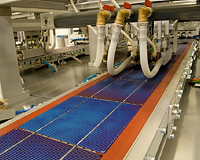 |
New Delhi (AFP) Oct 23, 2009 For more than 100 Indian villages cut off from grid electricity, life no longer comes to an end after dark thanks to an innovative solar-powered lantern that offers hope to the nation's rural poor. While cooking, farming and studying after sunset were once a struggle using inefficient kerosene or paraffin lamps, the solar lantern now provides a cheap and practical source of light. The simple device, which is charged during the day from a communal rooftop solar panel, uses between five and seven watts of power and has a battery that lasts up to eight hours. It also boasts a socket for charging mobile phones and a hand crank for topping up the power. Villagers pay between three and six rupees (six to 13 US cents) a day to rent the lantern under the "Lighting a Billion Lives" (LaBL) scheme, which was launched last year to promote solar energy as the environmentally friendly answer to India's energy shortages. "I keep my shop open as late as 9:00 pm. All my fish get sold by that time," a fish seller in Govindorampur district in West Bengal state who uses the lamp told researchers. He is one of those whose lives have been transformed by the first wave of 5,000 lanterns distributed across nine states in India. The LaBL scheme, run by The Energy and Resources Institute (TERI) in New Delhi, plans to eventually put 200 million lamps into use. Organisers say each lamp should work for ten years, saving between 500 and 600 litres of kerosene which would produce about 1.5 tonnes of carbon dioxide. Government figures show more than 10,000 impoverished Indian villages have no access to grid electricity, but the solar revolution could also change middle-class lives in urban India, where energy demands have soared. Power cuts are common even in the smarter suburbs of New Delhi, Mumbai and Kolkata as residents soak up fragile supplies with air-conditioning units, freezers and washing machines. While per capita electricity use in India -- 704 kilowatt hours in 2007-2008 -- is far lower than the 8,000 kilowatt hours per capita in many industrialised countries, there is no sign of consumption slowing. "There is something like 30 percent overdemand. There's significant undergeneration as it is, even if you don't electrify any more," said Joel Slonetsky, a researcher with LaBL. One "green" solution to the outages is a solar-charged inverter for backup electricity during cuts. "People have started realising the scarcity of power," said Chandra Sekhar, CEO of Solar India Solutions, which sells the inverters in the southern state of Andhra Pradesh. "They have become scared so they don't mind spending an extra little." Sekhar said most of his clients belong to the "domestic middle-income group" and they choose to shell out between 3,000 to 6,000 dollars for the solar inverters that work as well as traditional ones. "Right now the technology is at a stage where we can say that it stands side by side with conventional electricity," said Ajay Prakash Shrivastava, president of the Solar Energy Society of India. Increased efficiency and new materials mean the price of solar-powered equipment has been coming down for years, although initial installation costs are steep, said Shrivastava. While the long-term benefits may be an incentive for some, he acknowledged that most people who have opted to use solar energy have done so out of necessity rather than a desire to be environmentally friendly. "There are certainly people thinking in that direction," said Shrivastava. "But that group is not very large." Slonetsky said although the Indian solar industry is constantly evolving, the options for domestic solar power use are still somewhat limited. "It may just be a lag both in terms of consumer awareness and supply here." he said. It is certainly not for lack of sunshine -- India receives a high level of solar radiation, equivalent to more than 5,000 trillion kilowatts or up to 3,200 hours of sun a year, according to government statistics. The government hopes to harness this potential into 20,000 megawatts of solar power by 2020 as part of its National Solar Mission to promote renewable energy. The plan envisions railway signals and water pumps eventually running on solar technology, but for now, villagers are content with the portable lamps that have made daily tasks such as cooking and cleaning easier. "The lanterns have changed our position in society," said Ayesha Begum from Sahsoul village in the eastern state of Bihar. Share This Article With Planet Earth
Related Links All About Solar Energy at SolarDaily.com
 The Sustainable Way To Make PV: Helios Technology's Experience
The Sustainable Way To Make PV: Helios Technology's ExperienceHamburg, Germany (SPX) Oct 22, 2009 Helios Technology of Kerself Group has come up with some innovative solutions, committed to total respect for the environment. As explained by Mr. Andrea Ragni, Helios Technology's Plant Manager during the 24th edition of the PV Conference in Hamburg, this is achieved thanks to integrated treatment with zero drainage of waste water (cell manufacturing process) that avoids all releases into the ... read more |
|
| The content herein, unless otherwise known to be public domain, are Copyright 1995-2009 - SpaceDaily. AFP and UPI Wire Stories are copyright Agence France-Presse and United Press International. ESA Portal Reports are copyright European Space Agency. All NASA sourced material is public domain. Additional copyrights may apply in whole or part to other bona fide parties. Advertising does not imply endorsement,agreement or approval of any opinions, statements or information provided by SpaceDaily on any Web page published or hosted by SpaceDaily. Privacy Statement |